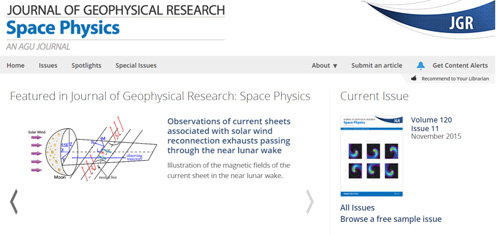Assistant Professor Xu Xiao Jun (first author) and Associate Professor Wong Hong Cheng (corresponding author) from Space Science Institute, Macao University of Science and Technology, published their research paper “Observations of Current Sheets Associated with Reconnection Exhausts Passing through the Near Lunar Wake” on Journal of Geophysical Research: Space Physics, a leading academic journal on geophysics recently. It is chosen as the research highlight on the current issue.
The researchers studied the magnetic field variation of the current sheets and found out that the lost plasmas may affect the magnetic field in the near lunar wake. It means that there is a permanent magnetic field on the moon or in the near lunar wake, which is caused by the movement of the solar wind plasmas. Therefore, when the universal frozen-in plasmas field is in the condition of low electric conductivity, for example, a nonmagnetic planet, we should not only consider the value of the electric conductivity, but also its size. If the object is large, the exterior plasmas have no effect on its inner magnetic field. The research has corrected a prevailing misunderstanding, and increased people’s knowledge about the magnetic change within different plasmas in the universe.
Neither atmosphere nor global intrinsic magnetic field exists on the moon, and the electric conductivity of the moon is so small that it may be neglected. So such planet could be taken as a big rock. When the magnetic field goes through it, which is nonconductive, the magnetic force lines remain the same. When the moon enters the earth’s magnetosphere, it will be surrounded by the solar wind. Without the magnetic screening, the part of the moon that faces the sun can absorb the solar wind particles. With the assumption that the moon has low conductivity, most scientists believe that though the solar wind particles are absorbed, the magnetic force lines can reach the inside of the moon. The magnetic field of the permanent magnet, which is exposed in the air, is controlled by the tiny current in the magnet. But the magnetic field of the solar wind is different. It is frozen with the solar wind plasmas and controlled by the local plasmas, which means the lost plasmas may affect the magnetic field that reaches the inside of the moon. It contradicts with the theory that the magnetic field remains unchanged when it enters the moon. Although it’s almost impossible to measure the inner magnetic field of the moon to study the change of the magnetic force lines, we can use the change of the magnetic field in the near lunar wake, which is also a nonconductive or low conductive environment, to study the change of the magnetic force lines of the solar wind when it reaches the moon.






